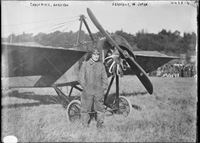Фотографии
-
Stinson’s mechanic for her Japanese visit and a pilot in his own right, Frank Champion is seen here standing in front of the Sempu-go Morane-Saulnier monoplane, which had been rebuilt after the crash of the original, in which Japanese pioneer Tsunesaburo Ogita was killed. Champion had no better luck in the rebuilt machine, being killed in it on June 3, 1917.
Самолёты на фотографии: Morane-Saulnier Type G/H - Франция - 1912
-
Preparing Smith’s aircraft for a flight in Japan sometime during his 1917 visit. Note the coloured bands applied to the Curtiss biplane’s rudder.
Самолёты на фотографии: Curtiss Golden Flyer / Model D - США - 1909
-
Offering a technological extravaganza never before witnessed in Japan, Smith brought five ‘‘baby racing cars” with him, which would be used to provide ground-based entertainment in the form of races in between Smith’s flying demonstrations. On occasion Smith would race the cars around the track in his aircraft.
Самолёты на фотографии: Curtiss Golden Flyer / Model D - США - 1909
-
Smith was renowned as a master of the loop, his ‘‘showstopper” being a series of consecutive loops often followed by a spiral descent with smoke flares illuminating his path through the sky, as depicted in this (doubtless heavily retouched) postcard. Once the “falling leaf” manoeuvre was complete, Smith would land the machine to rapturous applause.
Самолёты на фотографии: Curtiss Golden Flyer / Model D - США - 1909
-
Bearing a special stamp with a propeller motif commemorating Smith’s visit, this postcard shows Art Smith and his mother, who accompanied the aviator on his second visit to Japan, with his Curtiss-type pusher biplane. Despite encountering some hostility on his first visit, Smith appeared happy to return the following year.
Самолёты на фотографии: Curtiss Golden Flyer / Model D - США - 1909
-
The spectacle of daring stunts performed by exotic foreigners in state-of-the-art flyingmachines lent itself to the production of numerous contemporary postcards in Japan, this example depicting Art Smith in his Curtiss Model D-type preparing to take off for another of his innovative exhibition flights in Japan during 1916-17.
Самолёты на фотографии: Curtiss Golden Flyer / Model D - США - 1909
-
A wonderfully evocative postcard depicting Katherine Stinson astride a horse beside her Partridge-Keller biplane. Specially stressed for aerobatics, the aircraft had a span of 30ft (9-15m) and was powered by a 50 h.p. water-cooled six-cylinder Kirkham engine.
Самолёты на фотографии: Partridge-Keller Looper - США - 1914
-
Stinson poses in a kimono beside an aeroplane in Japan.
Самолёты на фотографии: Partridge-Keller Looper - США - 1914
Статьи
- -
- A.Arthy - Last Days Of The Cannon Birds
- E.Young - American aviators in Japan (2)
- G.Ellis - Rhodesia's Bush Eagles (1)
- K.Hayward - Out of the ashes
- L.Andersson - Wings over Baghdad
- L.Hellstrom - Sweden's Carribean connection
- M.Wickstead - Bringing Africa together (1)
- P.Davidson - Off the Beaten Track...
- P.Jarrett - Lost & Found
- P.Lewis - Hunter 80 (2)
- R.Lezon, M.Willis - Far-flung Flycatcher
- R.Pegram - Short's Empire landplane
- U.Vicenzi - Aces High







